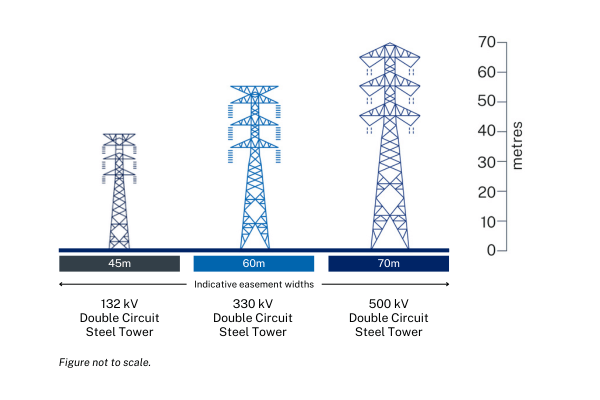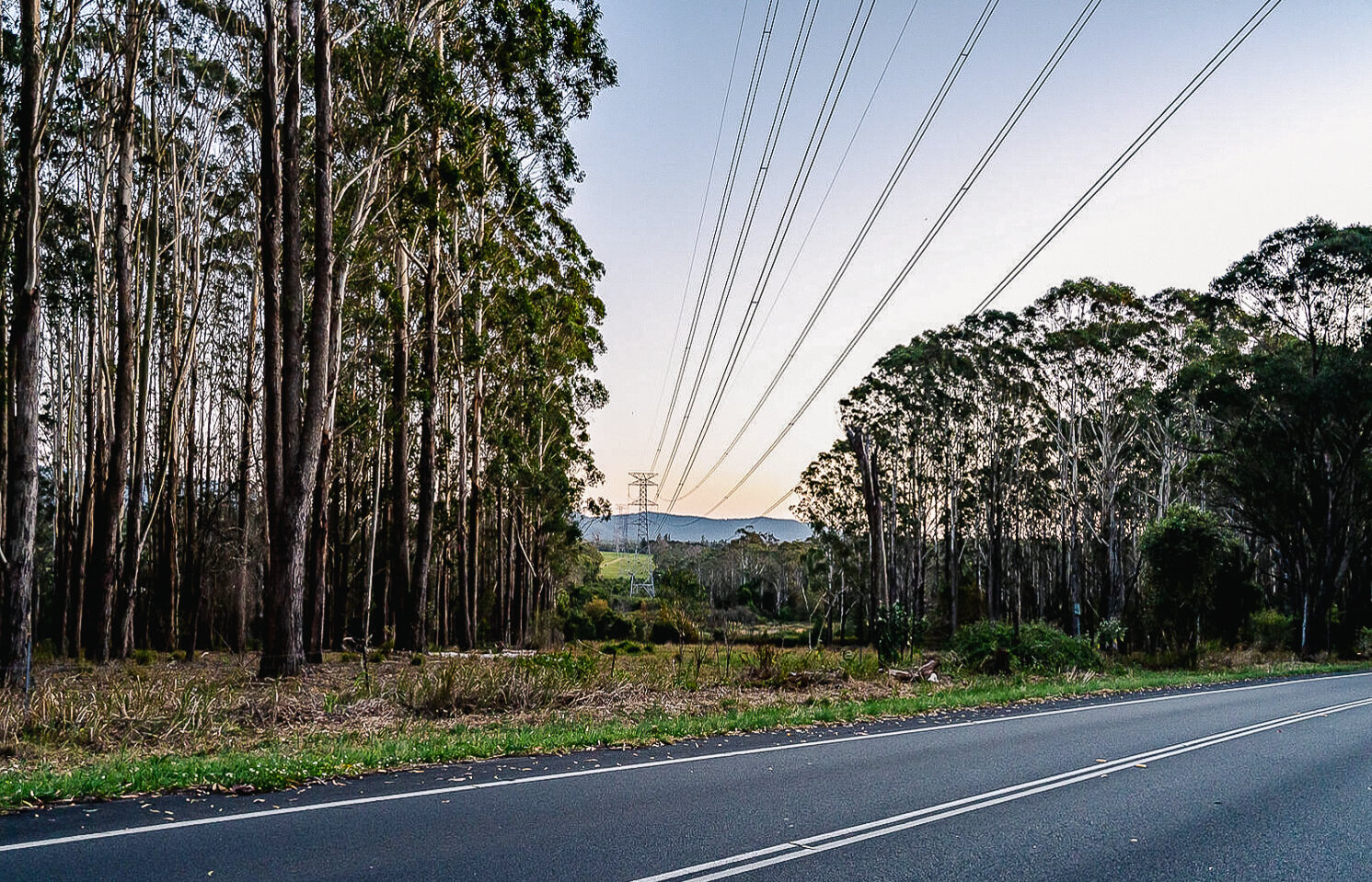Frequently asked questions
We're growing our list of FAQs and we want to hear from you.
Please contact our community team on [email protected] to suggest a question.
The Hunter Transmission Project (HTP) is one of the State’s most critical energy projects and will provide clean and reliable electricity to consumers for generations to come. It involves building a new overhead 500 kilovolt (kV) transmission line and supporting infrastructure including 2 new switching stations (at Bayswater and in the Olney State Forest).
The HTP will help create a 500 kV ring of transmission infrastructure that will be the backbone of the State’s electricity system for generations to come. As the remaining coal-fired power stations close, existing transmission lines lack the capacity required to transfer the electricity generated in new renewable energy zones (REZs) to consumers.
We presented the refined Hunter Transmission Project corridor to the community in May 2024. The new transmission line will run from Bayswater to Eraring via a new switching station in the Olney State Forest.
Construction is expected to begin in late 2026 but the project needs approval from both the NSW Government and Australian Government before it can proceed. An environmental impact statement (EIS) for the HTP will be placed on public exhibition in mid-2025.
Most of our ageing coal-fired power stations are due to shut in the next 10 years. At the same time, our demand for electricity is increasing as our population grows and we electrify our vehicles, homes, businesses and industry. This demand will be supplied by renewable energy. The HTP is the missing piece in the State’s new electricity grid and is needed to deliver clean electricity from the State’s new REZs to consumers across NSW – this is why it’s critical to energy security.
The existing 300 kV transmission infrastructure between Bayswater and Eraring is more than 30 years old. It’s inadequate to carry the large volume of electricity needed to meet growing demand in NSW. New 500 kV transmission lines from the State’s north and west will bring clean energy from the REZs to Bayswater. Then the HTP will ‘close the loop’ by transporting it to consumers, providing a reliable supply of energy for generations to come.
After extensive investigations, we’ve identified a corridor where the HTP could be located that strikes a reasonable balance between different land uses in the Hunter.
Most of the HTP corridor crosses mining, industrial and suitable public land. It also avoids sensitive areas such as major towns and villages, national parks and the Pokolbin wine/tourist area.
Read more about route selection in our Refining the Hunter Transmission Project report.
The existing 330 kV transmission easement between Bayswater and Richmond Vale
This option would be more expensive because the existing lines would need to be taken down and rebuilt to create space for the HTP. It would also take longer, ruling out any likelihood of delivering the HTP by late 2029.
This is because the existing lines are essential for supplying electricity to Newcastle, making it difficult to secure the outages needed to construct the new transmission line. Finally, it would increase energy security risks in NSW by concentrating all electricity supply between Bayswater and Newcastle in a single easement.
Next to the existing 330 kV transmission easement
This option would cause significant land use conflicts in the Pokolbin wine/tourist area and surrounding residential areas. It would also cause extensive clearing of endangered valley floor vegetation.
This includes the Warkworth Sands Woodland and Central Hunter Valley eucalyptus forest and woodland in areas such as the Singleton Military Area, Werakata State Conservation Area (SCA) and Werakata National Park.
The bushland to the south of the Pokolbin wine/tourist area
This option would result in an even greater clearing of endangered valley floor vegetation in the Werakata SCA and Werakata National Park. This vegetation provides critical habitat for several threatened species such as the swift parrot and regent honeyeater.
This option would also cause significant landscape-wide visual impacts in the rural residential areas around Ellalong and Quorrobolong.
The valley further south of the Pokolbin wine/tourist area
This option would result in significant land use conflicts with the growing residential areas around Millfield and Mount View. It would also cause significant landscape-wide visual impacts in the rural residential areas around Ellalong and Quorrobolong.
See EnergyCo’s interactive map
Because they’re essential to the existing network (to keep the lights on) and they’re not big enough to carry the loads from the renewable energy zones.
We’re also planning ahead and may need a second 500 kV transmission line (HTP2) in the future (source: NSW Network Infrastructure Strategy, May 2023). This could be achieved by upgrading the existing 330 kV easement – because the HTP will be able to provide energy security while it’s upgraded.
See EnergyCo’s interactive map
Yes – treading lightly to minimise impacts on the environment is a guiding principle for the project. A detailed assessment of environmental impacts will continue in 2025 as part of the HTP’s environmental impact statement (EIS), which forms part of the project’s approval process.
Read more about protecting the environment and biodiversity in our report Refining the HTP
Yes. We’re committed to finding ways to minimise the impacts of the HTP on all stakeholders. We're working together to minimise the project’s impacts on sensitive areas and Aboriginal cultural heritage by understanding what’s important to Aboriginal stakeholders and undertaking cultural mapping in the State forests.
A detailed assessment of impacts to Aboriginal cultural heritage will form part of the HTP's environmental impact statement.
We're also working with these groups to increase income and employment opportunities for the local Aboriginal community in line with the First Nations Guidelines
Read more about how we’re engaging with the Aboriginal community in our report Refining the HTP
Yes. The revised HTP corridor has reduced the number of affected private landowners from 78 (in the preliminary corridor) to fewer than 25. Most of the HTP corridor runs through mining, industrial and government land. We’re engaging with the affected landholders to identify concerns and minimise impacts where possible.
During 2025 we're doing more technical investigations and continue working closely with the community as we develop and refine the HTP’s design, including the location of around 230 transmission towers. Protecting scenic views, important biodiversity and Aboriginal cultural heritage are priorities.
Most towers will be around 70 metres tall. They’re generally spaced between 400 and 600 metres apart.
The height of transmission towers is carefully calculated to provide appropriate insulation for the volume of energy being transported through high voltage lines. Also, to maintain safety clearance from the ground and surrounding vegetation. To ensure energy security in NSW for generations to come, we need the highest voltage transmission lines used on the NSW network (500 kV) to safely move bulk energy around the core grid.

EnergyCo's HTP community team are Hunter locals. Since October 2023 this team has been engaging with potentially affected landowners, listening to their feedback and explaining the project.
Ongoing conversations with landowners will further minimise the HTP’s impacts wherever possible and explain the compensation that’s available.
Yes. Affected private landholders will receive compensation to host transmission infrastructure on their land. In addition, they’ll receive a Strategic Benefit Payment of $200,000 per kilometre of transmission hosted, paid in annual instalments over 20 years. Our team will work with affected private landowners to minimise potential impacts and provide support during the compensation process.
We have a dedicated local team working with affected landowners. We’re available to meet with you, provide information and answer questions. Please email [email protected] or phone 1800 645 972.
In addition to providing clean and reliable electricity, the HTP will support economic growth in the Hunter. We will harness and build on the region’s diverse economic skill base and provide opportunities for the Hunter community to share in the benefits of the project. That means:
- developing a targeted Hunter-first benefits program to ensure the community receives meaningful benefits during and after the HTP's construction
- working with local councils and the community to fund local projects
- increasing income and employment opportunities for the local Aboriginal community
- employing as many locals as possible and purchasing goods and services from Hunter businesses
- delivering strategic biodiversity offsets.
The best way to stay informed about the HTP is to sign up for our regular newsletter updates. These feature project updates and notifications, fact sheets, explainer videos and frequently asked questions. We'll also let you know about upcoming information sessions, workshops and field work investigations along the HTP corridor.
There’ll be an opportunity to provide formal feedback on the HTP’s detailed design in mid-2025 as part of the EIS process.
We have a dedicated local team available to provide information to you and answer questions. Please contact our community team by email [email protected] or phone 1800 645 972.
No. There may some temporary noise, dust and traffic impacts as the HTP is constructed – this will be examined as part of the HTP's environmental impact statement. Transmission lines produce extremely low EMFs (electro and magnetic fields), according to the World Health Organisation. EMFs are present in the atmosphere and whenever we use electricity in everyday life – for example when you use household appliances.
Read more about electro and magnetic fields
Read more about living and working with transmission line easements
The HTP has been declared critical State significant infrastructure because it is essential for energy security. However, all project details including environmental and community impacts are yet to be assessed and approved by both the NSW Government and the Australian Government.
Our ageing coal-fired power stations are closing faster than expected, with most due to shut in the next 10 years. Australia’s biggest power station at Eraring is scheduled to close in 2025 – keep in mind it produces approximately 25% of the State’s power. Clean energy from the new REZs is needed urgently to fill the gap. The HTP is a critical missing piece of infrastructure that will deliver this clean energy to consumers across NSW.
Energy security means we’ll have a reliable electricity supply in coming years as coal-fired power stations close and NSW transitions to clean energy.
No. The HTP corridor avoids both the Watagans National Park and Werakata National Park. It also avoids the Jilliby State Recreation Area.
We’re taking great care to cause the least possible impacts to landowners and the environment. The HTP corridor avoids and minimises impacts to environmentally sensitive land, including in forests. State forests are also used to grow commercial timber.
We received more than 250 submissions on the HTP preliminary corridor and the feedback was overwhelmingly constructive. It allowed EnergyCo to identify the issues of greatest concern and interest to the community. It was abundantly clear that protecting the environment and biodiversity as we build the HTP is the community’s top priority. Aboriginal cultural heritage, scenic views and route selection are also critically important.
Yes – the Hunter Transmission Project's environmental impact statement is currently on public exhibition. This is an important opportunity for formal feedback from the community.
More information
Community members were invited to have their say on the Hunter Transmission Project's preliminary corridor, until 18 December 2024.
Back to the Hunter Transmission Project overview
How EnergyCo is working with the HTP community
About the HTP regional reference group
More resources about the Hunter Transmission Project
Contact us
If you have any questions about the Hunter Transmission Project or would like to provide feedback, please contact us.
Email: [email protected]
Tel: 1800 645 972 (9am to 5pm, Monday to Friday)
You can also register for email updates here
